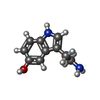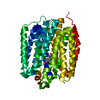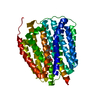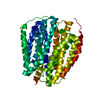+Search query
-Structure paper
| Title | Mechanisms of neurotransmitter transport and drug inhibition in human VMAT2. |
|---|---|
| Journal, issue, pages | Nature, Vol. 623, Issue 7989, Page 1086-1092, Year 2023 |
| Publish date | Nov 1, 2023 |
 Authors Authors | Shabareesh Pidathala / Shuyun Liao / Yaxin Dai / Xiao Li / Changkun Long / Chi-Lun Chang / Zhe Zhang / Chia-Hsueh Lee /   |
| PubMed Abstract | Monoamine neurotransmitters such as dopamine and serotonin control important brain pathways, including movement, sleep, reward and mood. Dysfunction of monoaminergic circuits has been implicated in ...Monoamine neurotransmitters such as dopamine and serotonin control important brain pathways, including movement, sleep, reward and mood. Dysfunction of monoaminergic circuits has been implicated in various neurodegenerative and neuropsychiatric disorders. Vesicular monoamine transporters (VMATs) pack monoamines into vesicles for synaptic release and are essential to neurotransmission. VMATs are also therapeutic drug targets for a number of different conditions. Despite the importance of these transporters, the mechanisms of substrate transport and drug inhibition of VMATs have remained elusive. Here we report cryo-electron microscopy structures of the human vesicular monoamine transporter VMAT2 in complex with the antichorea drug tetrabenazine, the antihypertensive drug reserpine or the substrate serotonin. Remarkably, the two drugs use completely distinct inhibition mechanisms. Tetrabenazine binds VMAT2 in a lumen-facing conformation, locking the luminal gating lid in an occluded state to arrest the transport cycle. By contrast, reserpine binds in a cytoplasm-facing conformation, expanding the vestibule and blocking substrate access. Structural analyses of VMAT2 also reveal the conformational changes following transporter isomerization that drive substrate transport into the vesicle. These findings provide a structural framework for understanding the physiology and pharmacology of neurotransmitter packaging by synaptic vesicular transporters. |
 External links External links |  Nature / Nature /  PubMed:37914936 PubMed:37914936 |
| Methods | EM (single particle) |
| Resolution | 2.89 - 3.72 Å |
| Structure data | EMDB-41066, PDB-8t69: EMDB-41067, PDB-8t6a: EMDB-41068, PDB-8t6b: |
| Chemicals |  ChemComp-YHL:  ChemComp-YHR:  ChemComp-SRO: |
| Source |
|
 Keywords Keywords |  MEMBRANE PROTEIN / MEMBRANE PROTEIN /  transporter transporter |
 Movie
Movie Controller
Controller Structure viewers
Structure viewers About Yorodumi Papers
About Yorodumi Papers










